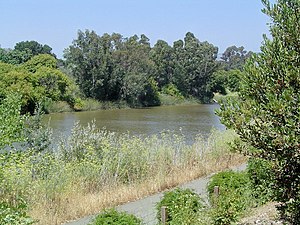| Napa River | |
|---|---|
 | |
 Napa River watershed (Interactive map) | |
| Location | |
| Country | United States |
| State | California |
| Region | Napa County, Solano County |
| City | Napa |
| Physical characteristics | |
| Source | Mount Saint Helena |
| • location | Mayacamas Mountains |
| • coordinates | 38°39′52″N 122°37′14″W / 38.66444°N 122.62056°W[1] |
| • elevation | 3,745 ft (1,141 m)[2] |
| Mouth | Carquinez Strait |
• location | San Pablo Bay |
• coordinates | 38°4′12″N 122°14′38″W / 38.07000°N 122.24389°W[1] |
• elevation | 0 ft (0 m) |
| Length | 55 mi (89 km)[3] |
| Basin size | 426 sq mi (1,100 km2)[4] |
| Discharge | |
| • average | 210 cu ft/s (5.9 m3/s) |
| • minimum | 0 cu ft/s (0 m3/s) |
| • maximum | 26,200 cu ft/s (740 m3/s) |
| Basin features | |
| Tributaries | |
| • left | Conn Creek, Rector Creek, Soda Creek, Milliken Creek, Suscol Creek |
| • right | Dry Creek, Napa Creek, Carneros Creek |
The Napa River is a river approximately 55 miles (89 km) long in the U.S. state of California. It drains a famous wine-growing region called the Napa Valley, in the mountains north of the San Francisco Bay. Milliken Creek and Mt. Veeder watersheds are a few of its many tributaries. The river mouth is at Vallejo, where the intertidal zone of fresh and salt waters flow into the Carquinez Strait and the San Pablo Bay.
- ^ a b U.S. Geological Survey Geographic Names Information System: Napa River
- ^ Google Earth elevation for source coordinates
- ^ About Napa River Archived 2009-05-05 at the Wayback Machine, Developing A Nutrient Management Plan for Napa River Watershed
- ^ Napa River Watershed Archived 2008-05-11 at the Wayback Machine, Napa County Resource Conservation District